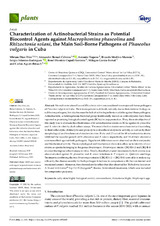Mostrar el registro sencillo del ítem
Characterization of Actinobacterial Strains as Potential Biocontrol Agents against Macrophomina phaseolina and Rhizoctonia solani, the Main Soil-Borne Pathogens of Phaseolus vulgaris in Cuba
| dc.contributor.author | Díaz-Díaz, Miriam | |
| dc.contributor.author | Bernal-Cabrera, Alexander | |
| dc.contributor.author | Trapero Casas, Antonio | |
| dc.contributor.author | Medina-Marrero, Ricardo | |
| dc.contributor.author | Sifontes-Rodríguez, Sergio | |
| dc.contributor.author | Cupull-Santana, René Dionisio | |
| dc.contributor.author | García-Bernal, Milagro | |
| dc.contributor.author | Agustí-Brisach, Carlos | |
| dc.date.accessioned | 2022-03-01T10:27:36Z | |
| dc.date.available | 2022-03-01T10:27:36Z | |
| dc.date.issued | 2022 | |
| dc.identifier.uri | http://hdl.handle.net/10396/22632 | |
| dc.description.abstract | Macrophomina phaseolina and Rhizoctonia solani are considered two major soil-borne pathogens of Phaseolus vulgaris in Cuba. Their management is difficult, not only due to their intrinsic biology as soil-borne pathogens, but also because the lack of active ingredients available against these pathogens. Actinobacteria, a heterogeneous bacterial group traditionally known as actinomycetes have been reported as promising biological control agents (BCAs) in crop protection. Thus, the main objective of this study was to evaluate the effectiveness of 60 actinobacterial strains as BCAs against M. phaseolina and R. solani in vitro by dual culture assays. The most effective strains were characterized according to their cellulolytic, chitinolytic and proteolytic extracellular enzymatic activity, as well as by their morphological and biochemical characters in vitro. Forty and 25 out of the 60 actinobacteria strains inhibited the mycelial growth of M. phaseolina and R. solani, respectively, and 18 of them showed a common effect against both pathogens. Significant differences were observed on their enzymatic and biochemical activity. The morphological and biochemical characters allow us to identify all our strains as species belonging to the genus Streptomyces. Streptomyces strains CBQ-EA-2 and CBQ-B-8 showed the highest effectiveness in vitro. Finally, the effect of seed treatments by both strains was also evaluated against M. phaseolina and R. solani infections in P. vulgaris cv. Quivicán seedlings. Treatments combining the two Streptomyces strains (CBQ-EA-2 + CBQ-B-8) were able to reduce significantly the disease severity for both pathogen infections in comparison with the non-treated and inoculated control. Moreover, they showed similar effect than that observed for Trichoderma harzianum A-34 and with Celest® Top 312 FS (Syngenta®; Basilea, Switzerland) treatments, which were included for comparative purposes. | es_ES |
| dc.format.mimetype | application/pdf | es_ES |
| dc.language.iso | eng | es_ES |
| dc.publisher | MDPI | es_ES |
| dc.rights | https://creativecommons.org/licenses/by/4.0/ | es_ES |
| dc.source | Plants 11(5), 645 (2022) | es_ES |
| dc.subject | Ashy stem blight | es_ES |
| dc.subject | Biological control | es_ES |
| dc.subject | Common bean | es_ES |
| dc.subject | Rhizoctonia blight | es_ES |
| dc.subject | Streptomyces spp. | es_ES |
| dc.title | Characterization of Actinobacterial Strains as Potential Biocontrol Agents against Macrophomina phaseolina and Rhizoctonia solani, the Main Soil-Borne Pathogens of Phaseolus vulgaris in Cuba | es_ES |
| dc.type | info:eu-repo/semantics/article | es_ES |
| dc.relation.publisherversion | https://doi.org/10.3390/plants11050645 | es_ES |
| dc.relation.projectID | Gobierno de España. CEX2019-000968-M | es_ES |
| dc.rights.accessRights | info:eu-repo/semantics/openAccess | es_ES |

